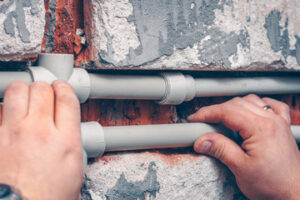Pipelining is a non-invasive plumbing solution that involves running lines soaked in epoxy resin through your pipes. This is a great option for fixing problems such as tuberculation, corrosion, and leaky joints.

Before the lining process can begin, your pipes will need to be evaluated with a sewer camera inspection to ensure that they are a good candidate for the trenchless method. Keep reading the article below to learn more about Epoxy Pipe Lining.
Over time, pipes can become corroded, blocked or clogged by debris and buildup. This can cause leaks, which can lead to expensive water bills and damage to your property. Epoxy pipe lining can restore your pipes to their original condition and extend their useful life by up to 50 years. This process is less invasive than traditional repiping and can be completed without disrupting your home or business.
Epoxy pipe liners can be applied to a variety of pipes, including PVC, steel, iron and copper. However, it is best to consult with a plumber before deciding if epoxy is right for your needs. They will be able to advise you on whether your pipes are suitable for this solution, and help you choose the right option for your home or business.
This method of plumbing repair is also environmentally friendly. It eliminates the need for excavation and reduces the amount of waste produced. Additionally, the epoxy used in piping restoration is made from recycled materials and does not release any harmful chemicals into the environment.
Another benefit of the epoxy pipe lining procedure is that it does not disturb the surrounding landscape or architecture. This can save you money on landscaping and renovation costs, as well as prevent any disruption to your home or business. The epoxy pipe lining process is also much quicker than traditional repiping, as it does not require the removal of existing pipes.
The first step in the epoxy pipe lining process is to inspect your pipes with a sewer camera inspection. This will ensure that the old pipes are in good condition and have the right diameter for this solution. Once the pipes have been approved for lining, they will be prepped by cleaning and sandblasting. They will then be soaked in epoxy resin, which is allowed to cure. This usually only takes a few hours up to a day, depending on the size of the pipes. This is much faster than the repiping process, which can take days or weeks. It is also more affordable, as repiping can cost thousands of dollars.
It’s Durable
If you’re looking for a durable, environmentally friendly pipe repair solution, epoxy is the answer. It can be used to line a wide variety of pipes, including concrete, clay, cast iron, and PVC. It can be used for both residential and commercial properties. The process is also very affordable compared to traditional pipe replacement. During this non-invasive, trenchless repair process, a pipelining expert will put an epoxy resin inside the old pipe. The resin will seal any cracks or holes, and it will also prevent new leaks from occurring in the future.
It’s a great option for anyone who has problems with their plumbing, including blocked pipes, water leaks and structural damage due to corrosion. Leaky pipes can encourage mold and mildew growth, which is dangerous for people’s health and can cause serious property damage. Additionally, it can lead to higher energy bills because of the leaky water and waste that are lost.
One of the best things about piping epoxy is that it can be used on any kind of pipe, regardless of its size or layout. It’s commonly used for drain and sewer lines, but it can be applied to potable water pipes, hot water recirculation systems, fire sprinklers, chiller lines, and HVAC systems. The coating is designed to be strong and resistant to wear and tear, so it can last up to 50 years.
The lining process starts with a thorough sewer camera inspection to assess the condition of the existing pipes. Then, the pipes are cleaned with hydro jetting to remove any debris or blockages. Next, the flexible epoxy-saturated liner is pushed into place, and an internal bladder is inflated to press the liner against the pipe wall. The liner is cured in place, which usually takes 4-8 hours. Once it’s done, the bladder is removed and a final camera inspection is performed.
Epoxy pipe lining is a cost-effective, non-invasive alternative to traditional pipe repair methods. It can save you 50% to 75% in repair costs, and it doesn’t require destroying your landscape or building structure. Plus, it’s safe for the environment and doesn’t produce any hazardous waste.
It’s Fast
While it may seem complicated to understand how epoxy pipe lining works, once you do, you’ll see that it is a simple, quick, and affordable solution to clogged pipes, blocked drains, water damage, and other plumbing issues. When you hire an experienced plumber, like those at Accurate Leak, to take care of your pipe lining needs, you can rest assured that it will be done quickly and correctly.
During the pipelining process, your old pipes will be thoroughly cleaned to remove any debris that may be causing blockages or other problems. After the pipes have been prepped, an air bladder will be inserted into your pipe and then the epoxy liner will be placed in the pipe, which is then cured with an epoxy resin. This entire process typically takes no more than a day, depending on the state of your pipes.
The fact is that epoxy pipe lining is significantly faster than traditional repiping. Since it is non-invasive, there is no need to tear down walls or floors, so it can be completed in a much shorter amount of time. Plus, since it’s an eco-friendly process, there is less of a chance of landfill waste and no need to manufacture new pipes.
It’s also more affordable than repiping. When you consider all of the costs associated with traditional repiping, including reconstruction costs, it can cost 50% to 75% more than having your pipes lined. Plus, you’ll save on energy bills because your pipes will be functioning properly again and maximizing their internal diameter.
Another advantage of epoxy lining is that it can be used in all types of pipes. This includes potable water lines, sewer pipes, drainage pipes, and more. In addition, it is NSF certified to ensure that it meets or exceeds all of the strict rules and standards for drinking water pipes.
Whether your pipe system is in good condition or in need of repair, it’s important to know your options. By learning about the benefits of epoxy pipe lining, you can decide whether it’s the right option for your residential or commercial property.
It’s Affordable
Pipes are a vital part of your plumbing system, but when they start to fail and leak, it can be expensive to replace them. However, if you opt to use epoxy lining for your pipes, you can get your plumbing back in working condition without having to pay for a complete repipe. This is because the epoxy liners cost much less than traditional pipes, so you’ll save a lot of money in the long run.
Epoxy liners are a great option for commercial and residential properties, as well as schools and hospitals. They are also great for the environment as they reduce the need for new pipes and minimizes excavation waste and the consumption of raw materials. They can be used in a variety of pipe sizes and layouts, too.
The process starts with a comprehensive evaluation of your existing pipes. This includes the use of video sewer cameras to assess the condition of your plumbing system and determine if epoxy lining is the right choice for you. Once the evaluation has been completed, the plumber will prepare your pipes for the lining process. This involves using a high-pressure water jet sprayer and other specialized tools to remove fat, oil, grease, sediment, tree roots and other debris from your pipes. The pipes are then sandblasted to clean them so that the epoxy can bond with the interior surface of the pipes.
Once the liners are in place, your plumber will run water through them to make sure that they are functioning properly. The liners will seal any pinhole leaks and prevent future corrosion, so you can enjoy your plumbing for years to come without having to worry about major repairs or replacements. Furthermore, the liners will not leach chemicals and hard metals into your plumbing, which can cause significant damage to your walls and floors and harm your health.
When comparing the cost of a traditional repipe versus an epoxy lining solution, it is important to factor in all of the additional expenses that would be associated with the traditional method. For example, the labor charges of tearing out walls and flooring, landscaping costs, repairs to drywall and ceilings and other items can quickly cancel out any savings that you might see with a traditional repipe.


